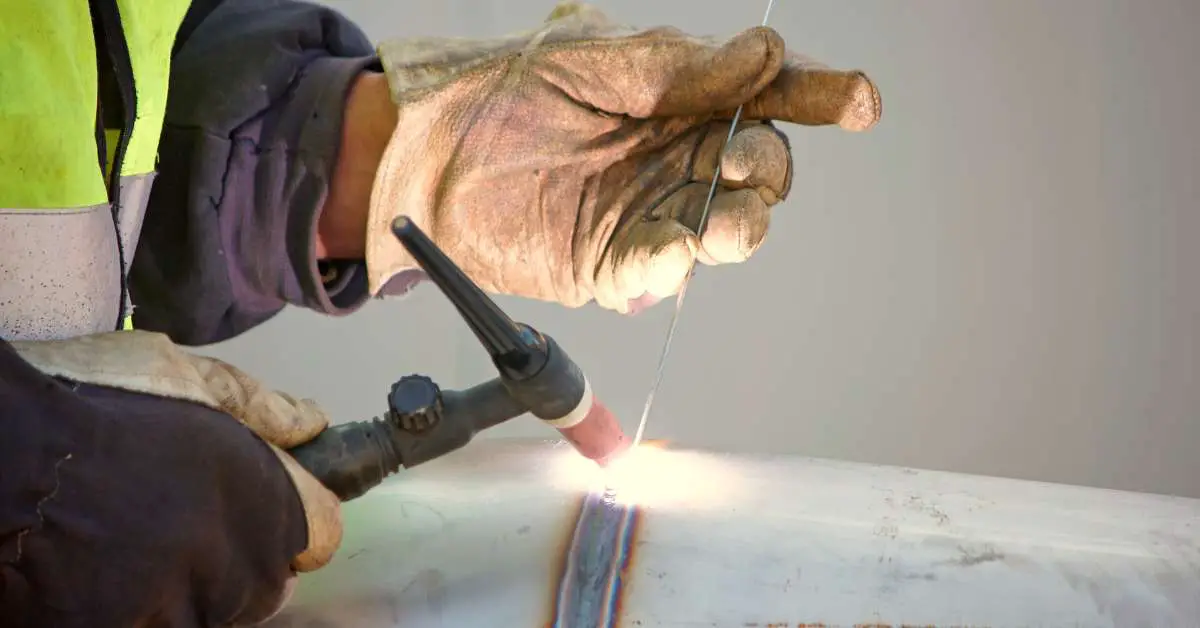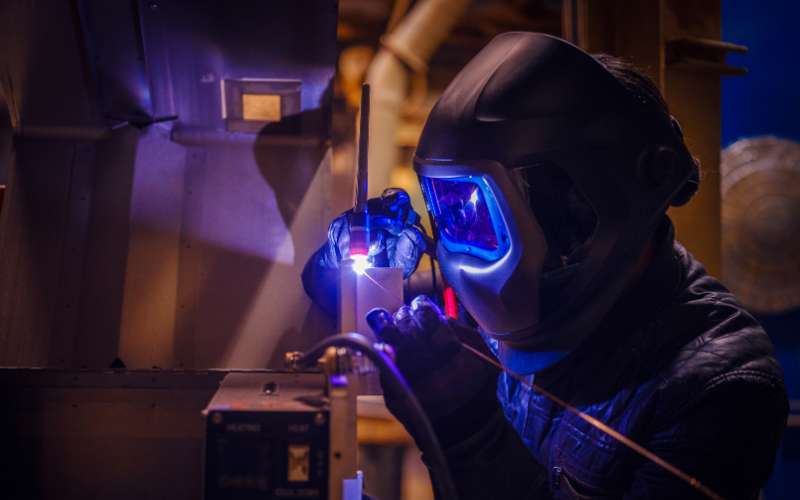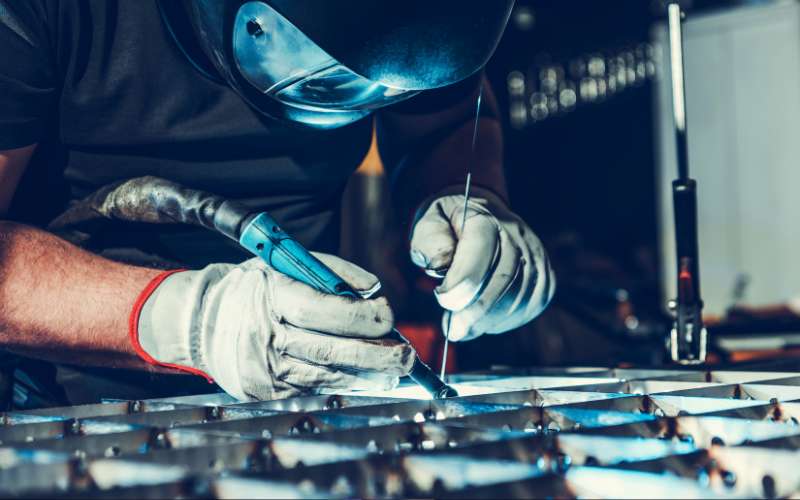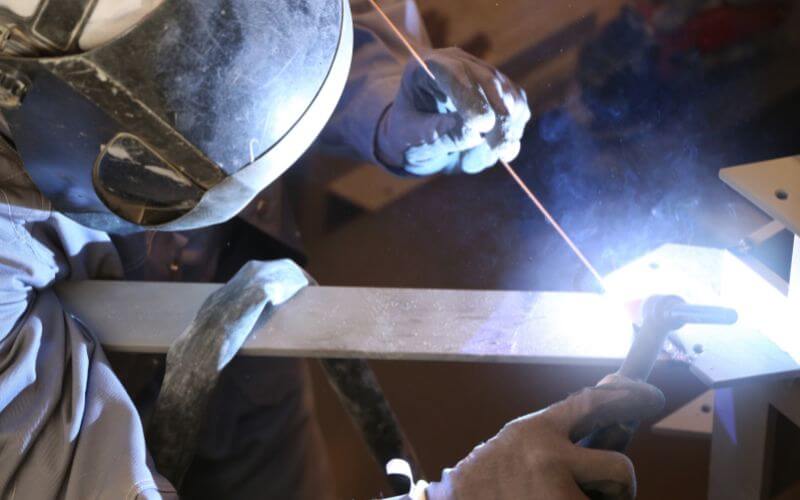Welding plays a pivotal role in many industries, with various techniques employed, such as Shielded Metal Arc Welding (SMAW) or Stick Welding, and Gas Metal Arc Welding (GMAW) or MIG welding. However, Tungsten Inert Gas (TIG) welding stands out for its precision, control, and skill requirements. It is also popularly considered as the hardest form of welding.
As the most challenging welding method, TIG welding is highly regarded for its complexity and attention to detail. It’s utilized for fabricating critical structures, joining exotic alloys, and creating masterpieces of unparalleled quality.
Join us in discovering TIG welding’s unique aspects, technical nuances, and challenges that only skilled welders can overcome.
What is TIG Welding?
TIG welding, or gas tungsten arc welding (GTAW), is an arc welding process using a non-consumable tungsten electrode to weld two materials. It’s typically employed for joining metals like stainless steel, aluminum, and nickel alloys, as it ensures precise heat control and high-quality welds.
During TIG welding, the tungsten electrode remains intact and generates an arc between itself and the workpiece. This creates an intense heat that melts the base metals and forms a weld pool protected by an inert shielding gas, such as argon or helium. This gas prevents oxidation and maintains weld integrity.
Differences Between TIG Welding and Other Forms of Welding
Welding processes may seem similar on the surface, but delving deeper, one can identify unique traits that set TIG welding apart from other commonly-used welding methods.
TIG Welding’s Unique Features
TIG (Tungsten Inert Gas) welding uses a non-consumable tungsten electrode to produce an arc required for welding. Additionally, it needs an external filler material to build the weld, distinctly separate from the heat source.
In this type of welding, a foot pedal is employed to control the heat input during the welding process. This allows the welder to adjust the heat in real time, ensuring accurate control over the welding arc, something not commonly found in other forms of welding.
Contrasting MIG and Stick Welding
In contrast, MIG (Metal Inert Gas) welding uses a continuously-fed consumable wire acting as both electrode for the creation of the arc and filler material. This makes MIG welding substantially different from TIG welding in terms of controlling the welding process.
Stick welding, or Shielded Metal Arc Welding (SMAW), employs a flux-coated consumable electrode, which produces the arc and also contributes to the filler material. Tungsten electrodes sizes are similar to stick electrodes, but burning is different; these electrodes heat the metal and form a puddle. In stick welding process, there’s no need for a separate filler rod, and it lacks a device like the foot pedal for heat control.
TIG stands out with its unique combination of torch control, heat regulation, and weld material management, making it distinct from other welding processes. These differences have implications for both the applications of TIG welding and the skill level required for mastery.
Related Article: MIG VS TIG Welding | Difference between MIG and TIG Welding
The Pros and Cons of TIG Welding
Pros
- High-quality welds with superior control and accuracy.
- Optimal for thin and low-heat materials like aluminum, magnesium, copper, and stainless steel.
- Less spatter and slag, eliminating post-weld clean-up needs.
- Environmentally friendly; no smoke, fumes, or hazardous gases emitted.
Cons
- Most complicated setup, technique, and safety process among welding methods.
- Time-consuming and necessitates a skilled, experienced operator.
- More expensive than alternatives like Stick and MIG welding due to equipment and gas costs.
- Not suitable for thick materials and heavy-duty industrial applications.
- TIG welding requires welders to remain concentrated and controlled for extended periods of time as even the slightest offset can ruin the quality of the weld.
Technique and Safety Requirements for TIG Process
TIG welding demands a high level of skill and experience. To excel in this difficult welding technique, follow these guidelines:
1. Mastering the TIG Welding Technique
TIG welding necessitates a steady hand and precise control of the torch and filler rod. Welders must have excellent eyesight and hand-eye coordination to ensure consistent weld penetration and accuracy. Key outcomes include a flat, smooth, and uniform weld bead without undercutting or porosity.
2. Prioritizing Safety in TIG Welding
TIG welding can generate harmful UV radiation and ozone gases, posing risks to operators and bystanders. To mitigate these hazards, use appropriate personal protective equipment, including:
- Welding helmets with proper shade level.
- Heavy-duty gloves.
- Safety shoes.
- Long-sleeved jackets and aprons.
Additionally, ensure the workspace is well-ventilated and avoid welding in confined spaces.
3. Preparing the Workpiece for TIG Welding
A clean welding surface is crucial for TIG welding to penetrate the metal without damage. Prepare the workpiece by:
- Removing contaminants such as oil, rust, or dirt.
- Grinding the surface if necessary.
- Cleaning edges to be welded with a wire brush or solvent.
4. Fine-tuning TIG Welding Settings
Successfully executing TIG welding on various materials and thicknesses requires adjusting machine settings such as:
- Current (DC or AC).
- Voltage.
- Gas flow (argon or helium).
- Tungsten electrode size and type.
Consult the manufacturer’s guidelines or welding charts for specific settings. Remember that different metals may require changes in polarity, electrode preparation, or filler material composition.
What Makes TIG Welding the Hardest Form of Welding
TIG welding is often perceived as the most challenging welding technique due to factors that contribute to its complexity and precision. Let’s explore these aspects and determine why TIG welding is considered the hardest form of welding.
1. Too Many Variables in TIG Welding
TIG welding involves multiple variables that must be carefully controlled to achieve high-quality welds. Precise parameters such as heat input, weld speed, filler rod manipulation, and shielding gas flow rates demand concentration and expertise in managing each factor.
2. Mastering the Foot Pedal in TIG Welding
The use of a foot pedal in TIG welding adds another layer of complexity and dexterity. Welders must:
- Adjust amperage or welding current during TIG welding with the foot pedal.
- Coordinate foot movement with hand movements to maintain the desired amperage.
- Develop a feel for the pedal’s sensitivity and foot pressure to achieve precise control.
These intricate foot pedal adjustments place even more coordination and concentration demands on the welder.
3. Metal Prep for TIG Welding
Proper metal preparation is crucial in TIG welding to ensure high-quality welds. Before welding, welders must:
- Thoroughly clean the metal surface, removing contaminants like grease, dirt, oil, or rust.
- Employ mechanical processes like grinding, filing, sanding, or sandblasting.
- Use chemical processes such as solvents or cleaning solutions.
This meticulous preparation adds to the time and effort required for TIG welding but is critical for achieving the best results.
4. Avoiding Tungsten Contamination in TIG Welding
Tungsten contamination can significantly impact the quality and performance of TIG welds. Sourced from the non-consumable electrode, it is a common issue that welders must address. Tungsten contamination arises from:
- Filler metal transfer onto the tungsten electrode.
- Accidental contact with the molten filler metal or dipping into the weld pool.
Contaminated tungsten can lead to unstable arcs, spatter, porosity, and weld defects such as lack of fusion or penetration. To minimize these issues, welders should:
- Follow proper procedures for electrode handling.
- Maintain a clean work environment.
- Grind or replace the tungsten electrode as needed.
- Ensure proper shielding gas flow.
Skills Required for TIG Welding
TIG welding, reputed as the most challenging welding method, demands specialized skills and traits from the welders. Let’s illuminate the importance of patience, attention to detail, dexterity, and proper training in mastering TIG welding.
1. Patience and Attention to Detail
TIG welding is a meticulous process requiring careful control over numerous welding parameters such as heat input, weld speed, filler rod manipulation, and shielding gas flow rate. It also demands intense concentration to maintain a steady hand and precise coordination.
Moreover, the preparation for metal surface prior to TIG welding needs a systematic cleaning ritual. Thus, to achieve flawless welds, patience and careful attention to detail are critical for the welder, making these skills vital in TIG welding.
2. Dexterity and the Importance of Steady Hands
Dexterity is of utmost importance in TIG welding due to the multiple hand-eye coordination tasks involved. One hand manoeuvres the torch, while the other hand feeds the weld filler, all while using the foot to control heat input via a foot pedal.
Additionally, avoiding tungsten contamination, which can degrade welding quality, adds another level of complexity and demands a steady hand. Thus, a welder’s dexterity is paramount to master TIG welding.
3. The Importance of Proper Training and Experience
TIG welding, given its complexity and precision requirements, needs quality training and substantial practice. It involves understanding the intricate relationships between the multiple variables at play, and making accurate adjustments.
Proper training provides a solid foundation for understanding the principles of TIG welding, safety standards, and handling equipment, but it’s the consistent practice that builds familiarity and finesse with the technique.
Conclusion
Through our exploration into the intricacies of TIG welding, we’ve discovered the many challenges inherent in this precise welding technique. From having to manage numerous variables to the complex coordination involved in controlling the welding process with both hands and a foot pedal, TIG welding is indeed a demanding art form. However, it’s precisely these challenges that make mastering TIG welding a rewarding and uniquely fulfilling pursuit.
For those inspired to learn this method, remember that learning comes with patience and perseverance. The right training, coupled with dedicated practice, can transform these challenges into an admirable skill, opening numerous high-precision project opportunities. With TIG welding under your belt, you would stand out as a versatile and skilled welder.
To conclude, TIG welding, with its unique attributes and detailed precision, is a distinguished addition to any welder’s skill set. Its mastery demonstrates commendable dedication and talent, allowing welders to embrace a wide array of applications with supreme confidence. So, while it may seem daunting at first, the eventual rewards of mastering TIG welding are well worth the effort, bearing testament to your capabilities in this specialized trade.








